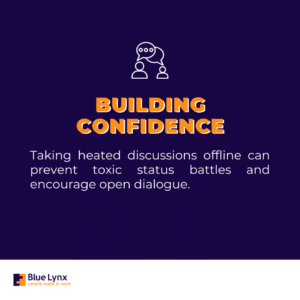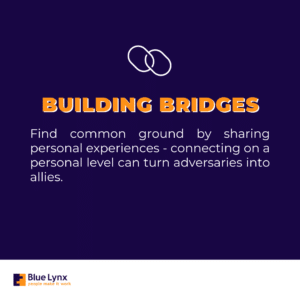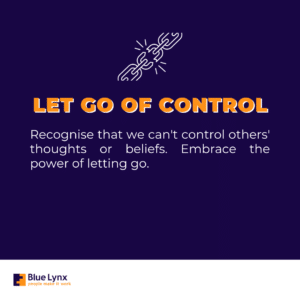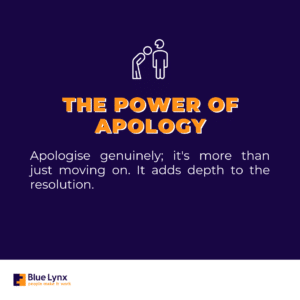Within an organisation, employees with diverse backgrounds, experiences, and perspectives interact with each other daily. As a result, the collision of ideas and opinions is not just commonplace but essential for innovation and progress. In fact, according to ZipDo, 85% of employees experience conflict in the workplace at some point. However, the way we navigate these disagreements plays a pivotal role in shaping both individual careers and the collective success of the organisation.
Effective conflict resolution is not merely a skill; it’s an art form that, when mastered, becomes a catalyst for personal and professional growth. The ability to navigate disagreements with tact and resilience transforms what could be perceived as obstacles into stepping stones toward greater understanding, collaboration, and innovation.
This article aims to serve as a guide through the labyrinth of workplace disagreements, offering strategic insights and practical strategies, grounded in organisational psychology, to not only navigate disagreements effectively but also to foster a workplace culture that thrives on diversity of thought and constructive dialogue.
Understanding The Dynamics of Disagreement
To navigate disagreements at work effectively, it is essential to understand the dynamics and the common causes.
Disagreements at work often find their roots in a variety of sources. From differences in communication styles and varying interpretations of goals to conflicting values and competition for resources, the spectrum of potential triggers is vast.
Recognising that these differences are not inherently negative but rather a natural consequence of diverse perspectives and backgrounds lays the foundation for proactive conflict resolution.
Dealing with Unresolved Conflicts
Unchecked disagreements have a profound influence on both individual and team dynamics.
At the individual level, unresolved conflicts can breed stress, hinder creativity, and impede personal growth.
Team performance, on the other hand, is affected by diminished collaboration, eroded trust, and a decline in overall productivity.
Unaddressed conflicts, much like a slow-burning fire, have the potential to smoulder beneath the surface, casting a shadow on the collective success of the organisation. What is more, workplace conflict costs businesses $359 billion annually.
Setting the Stage for Navigation Strategies
Addressing conflicts head-on is not just a matter of personal preference but a strategic necessity.
When approached constructively, disagreements can be transformative. By embracing the diversity of thought and perspectives that fuel disagreements, organisations can harness the energy generated by these clashes to propel themselves towards innovation and excellence.
How Does Conflict Impact Organisational Culture
Dealing with conflicts at work holds a profound influence on shaping an organisation’s culture. The way conflicts are addressed and resolved can either contribute positively to a healthy and thriving culture or become a source of dysfunction and discord.
The approach to conflict resolution sets a precedent for communication within the organisation. A culture that encourages open and honest discussions about conflicts fosters a sense of transparency and trust.
On the other hand, a culture that avoids or mishandles conflicts may give rise to an environment where employees fear speaking up, leading to a culture of silence or passive-aggressive behaviour.
The impact of conflict on organisational culture is closely tied to the organisation’s commitment to fairness and equity. When conflicts are managed impartially and resolutions are based on principles of fairness, it strengthens the perception that everyone is held to the same standards.
Conversely, inconsistent or biased conflict resolution can breed resentment, erode trust, and contribute to a toxic work culture.
What is more, how conflicts are addressed shapes the organisation’s approach to innovation and problem-solving. A culture that views conflicts as opportunities for growth and learning tends to be more innovative.
How conflicts are managed influences the quality of interpersonal connections and the overall sense of camaraderie.
A culture that encourages constructive conflict resolution can lead to stronger team bonds and a sense of unity. Conversely, unresolved or poorly managed conflicts can create rifts between people, fostering a culture of division and mistrust. In fact, 60% of HR professionals believe that workplace conflict is due to bad management.
The way an organisation responds to conflicts shapes its resilience and adaptability. A culture that embraces conflicts as a natural part of organisational life and addresses them promptly develops the ability to adapt to change and learn from challenges.
In contrast, a culture that avoids conflicts may struggle to navigate disruptions, hindering its capacity for growth and evolution.
The 5 Ways to Resolve Conflict
Building Bridges
This is a foundational skill in navigating disagreements. Rather than viewing differences as obstacles, the emphasis shifts towards finding common ground—a platform from which positive communication can flourish.
Looking for Common Ground
At the heart of constructive conflict resolution lies the conscious effort to seek out shared experiences, values, or objectives. Identifying common ground provides a solid foundation for communication, allowing individuals to connect on a human level beyond their professional roles.
Whether it’s a shared passion, similar career aspirations, or common personal values, finding these points of convergence establishes a sense of camaraderie that transcends the disagreement at hand.
Highlighting the Norm of Reciprocity
The Norm of Reciprocity, a fundamental principle in social psychology, is paramount to the process of building bridges. This norm suggests that people tend to respond to positive actions with positive actions, creating a cycle of cooperation.
In the context of workplace disagreements, when one party extends an olive branch by sharing personal insights or experiences, it often prompts reciprocal openness from the other party.
This reciprocity forms the basis for mutual understanding and paves the way for a more collaborative and harmonious working relationship.
How to Release the Need to Control
The need for control is deeply ingrained in human psychology, often stemming from a desire for predictability and security.
In the context of workplace disagreements, this need can manifest as an instinctive reaction to assert one’s perspective as the ‘correct’ or ‘superior’ viewpoint.
Unravelling the psychological layers of this inclination allows people to recognise its influence on their behaviour during disagreements.
Consequences of Forcefully Changing Others’ Opinions
Attempting to forcefully change others’ opinions in a disagreement can lead to a myriad of negative consequences. Rather than promoting understanding, such attempts often trigger defensiveness and resistance.
The person on the receiving end may become more entrenched in their stance, viewing the effort to change their mind as an attack on their autonomy. This not only intensifies the disagreement but erodes trust and hampers future collaboration.
Strategies to Embrace an Open-Minded Approach
Overcoming the urge to control requires a deliberate shift towards an open-minded approach.
Strategies include active listening, and genuinely seeking to understand others’ perspectives without immediately offering counterarguments.
Embracing the idea that differing opinions can coexist cultivates an environment where collaboration is prioritised over dominance.
Additionally, practising empathy and acknowledging the validity of diverse perspectives contribute to a more inclusive and cooperative workplace.
Recognising that relinquishing the need for control is not a sign of weakness but a strength that paves the way for constructive collaboration is a fundamental aspect of this transformative step.
Boosting Confidence and Fostering a Positive Environment
A psychologically safe workplace is a breeding ground for open dialogue and constructive conflict resolution.
Psychological safety in the workplace is a crucial factor that significantly impacts various aspects of organisational performance. In fact, it leads to 27% less turnover and 57% more improved collaboration among employees.

When employees feel secure in expressing their opinions without fear of judgment or reprisal, the stage is set for honest conversations.
Saving Face to Prevent Toxic Status Battles
By allowing people to gracefully step away from a disagreement without feeling a threat to their reputation, toxic status battles can be averted.
The phrase “taking things offline” is not merely a tactic but a recognition of the importance of saving face, creating a space to retreat, regroup, and return to the conversation with renewed perspectives.
Encouraging Collaboration over Confrontation
The shift from confrontation to collaboration is a paradigm that defines healthy workplace dynamics.
Encouraging employees to view disagreements as opportunities for joint problem-solving rather than as battles to be won transforms the narrative.
This collaborative mindset not only does it resolve immediate conflicts, but sets the stage for future interactions where differences are embraced as catalysts for innovation.
The Power of Genuine Apology
Understanding the weight carried by a sincere apology involves acknowledging its potential to heal wounds, restore trust, and pave the way for a more constructive and collaborative working environment.
A genuine apology communicates accountability and a commitment to rectify any unintentional harm caused.
It fosters an environment where people feel heard, respected, and valued. The impact is not confined to the immediate disagreement; it ripples through the broader professional relationship, creating a foundation for increased trust, mutual understanding, and a shared commitment to moving forward.
Tips for Crafting Meaningful Apologies
Crafting a meaningful apology requires intentionality and a genuine desire for resolution. Some key tips include:
- Take Responsibility
Explicitly acknowledge the specific actions or words that led to the disagreement.
- Express Regret
Convey genuine remorse for any unintended consequences or hurt feelings.
- Offer Amends
Propose tangible steps or solutions to rectify the situation and prevent a recurrence.
- Avoid Excuses
Steer clear of deflecting blame or making excuses. Own your part in the disagreement.
- Be Timely
Apologise as soon as possible to prevent the escalation of tensions and demonstrate proactive resolution.
Disrupting the Norm for Productive Disagreements
Many workplace disagreements fall prey to repetitive cycles, where the same arguments echo without reaching a satisfying resolution.
Recognising these patterns is the first step toward breaking free from their grip. Whether it’s a clash of personalities, recurring miscommunications, or disputes over resource allocation, acknowledging the repetitiveness allows individuals to step back, reevaluate, and approach the disagreement with a fresh perspective.
Introducing Novelty and Variation for Constructive Conversations
To disrupt the norm, injecting novelty and variation into conversations is key. This can involve altering the format of discussions, introducing new data or perspectives, or even changing the physical setting of the conversation.
By doing so, employees give way to fresh insights, creative solutions, and a departure from the stagnation that often accompanies recurring disagreements.
Real-Life Examples of Successful Disruption Leading to Resolution
Consider a team consistently grappling with the same issue, such as meeting deadlines.
Rather than repeating the same arguments, a manager disrupts the norm by introducing a collaborative project management tool. This change not only shifts the team’s approach but also fosters a sense of collective responsibility, ultimately resolving the recurrent conflict.
Another example could involve two colleagues with differing opinions on project strategy. Instead of rehashing the same points, they disrupt the pattern by inviting a neutral facilitator to guide the conversation.
This external perspective introduces novelty and variation, steering the discussion toward a more collaborative and solution-oriented path.
To Sum It Up
Disagreements are not roadblocks but rather opportunities for growth, understanding, and innovation. Begin by finding common ground, connecting on a personal level, and understanding the power of reciprocity in fostering understanding. Explore the psychological aspects of control, acknowledge the consequences of forcefully changing opinions, and embrace an open-minded approach for more constructive interactions.
It’s vital to create psychologically safe workplaces where open dialogue thrives, save face to prevent toxic status battles, and champion collaboration over confrontation. Understand the significance of sincere apologies in conflict resolution, recognise the impact of genuine remorse on workplace relationships, and employ practical tips for crafting meaningful apologies.
Finally, recognise and break free from repetitive patterns, introduce novelty and variation for more constructive conversations, and draw inspiration from real-life examples of successful disruption leading to resolution.
Navigating disagreements with empathy, strategic thinking, and a commitment to constructive resolution is not just a professional skill but a testament to the capacity for leadership and positive influence.
Embrace the nuances of disagreement, for within them lies the potential for stronger teams, innovative solutions, and a workplace culture that celebrates diversity of thought.



